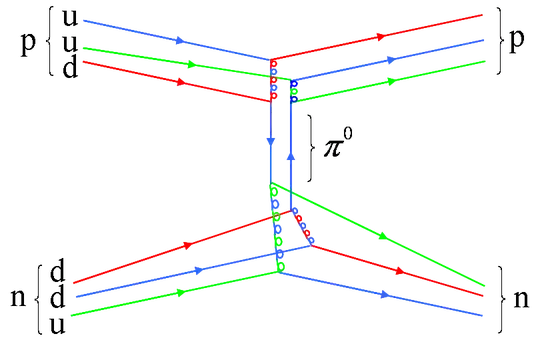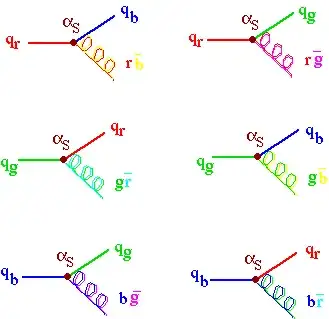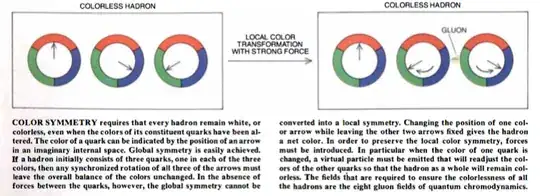I've read about colors relating to quarks and hadrons and I know that they can change colors because of the exchange with gluons, but does changing color change the type of hadron? Does a proton become a neutron because the quark color changes?
3 Answers
Hadrons come in 2 families: baryons and mesons. Both of them consist from colourless combinations of quarks. Mesons contain pairs of quarks of colour-anticolour and hadrons contain 3 quarks of different colours making them white in analogy with regular colour perception.
You are right that quark can change its colour by interaction with gluons, but the colour is conserved — it is just that gluons carry a pair of different colour-anticolours such that colour lines are always unbroken.
Although this seems cumbersome, this picture is well motivated by the group symmetry found in hadrons. Additionally, it explains why only baryons and mesons are observed by themselves and not quarks and gluons (which are not colourless or white).
Best illustration I've seen so far is here:
(from https://physics.stackexchange.com/a/2237/119172, look there for more technical explanations)
Be, however, cautious as in this picture gluons actually have colour and anticolour, but to decide which is which, you need to assign it a direction of movement.
Here it is better seen, as times goes from left to right:
(could not find the source)
- 1,188
- 7
- 20
No, not at all! The color of the quarks has no effect whatsoever.
If you're studied intro physics, you know that a potential $V(x)$ is identical in every way to a potential $V(x) + V_0$ for some constant $V_0$.
Now consider two hydrogen atoms, where I've set the potential at infinity to be $3 \text{ V}$ for one of them and $4 \text{ V}$ for the other. Then their potentials are slightly different, mathematically, but in every conceivable physical way the two systems are identical. We just have a redundancy in our description of the system.
This redundancy is called a gauge symmetry, and the color of quarks is built on a more complicated gauge symmetry called $SU(3)$. However, the same point stands: picking out "the" colors of the quarks in a hadron is as meaningless as pinning down the potential for a hydrogen atom. Specific colors exist in the math, but not in reality.
- 107,105
I think the above picture with captioning below answers the question best, at least for me. Basically the green quark emits a green-antiblue gluon, turning it blue. This gluon is absorbed by the blue gluon, and it changes from blue to green, restoring the color symmetry and keeping the Baryon overall colorless. And it happens so fast that no overall Baryon color can be observed.
Source: "Gauge Theories of the Forces Between Elementary Particles", Gerard 't Hooft, Scientific American, June 1980
- 572


